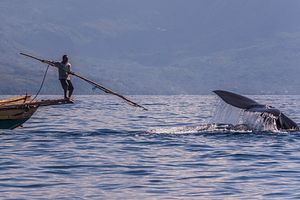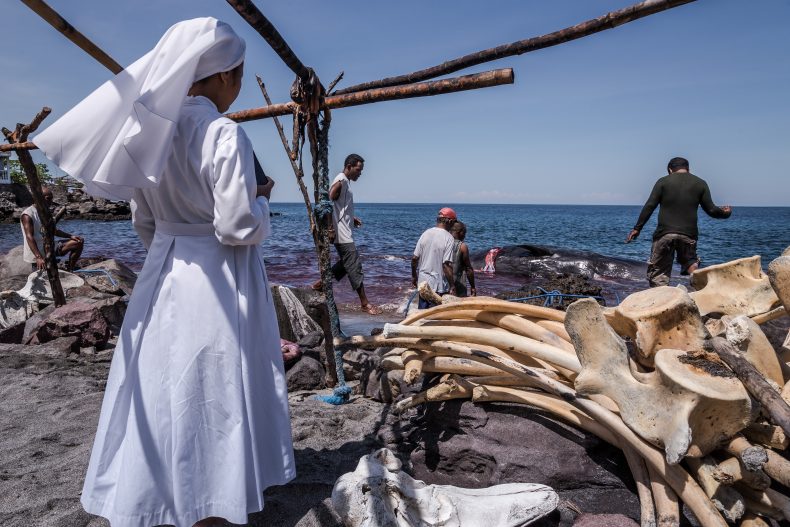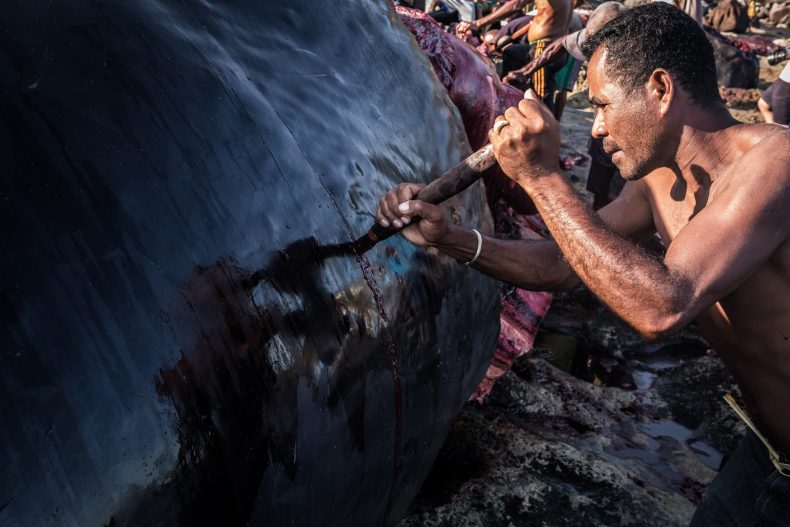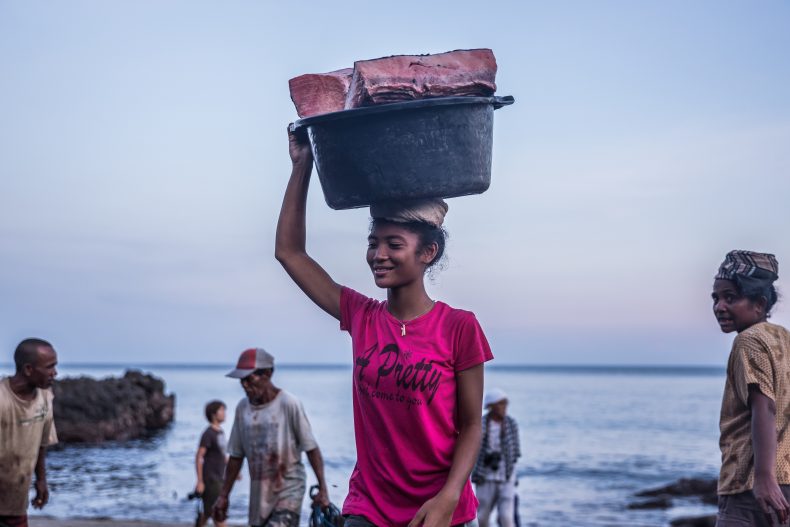On the islet of Lembata in the remote Indonesian province of Nusa Tenggara Timur, clans have been spearing and landing sperm whales by hand for at least six centuries. Their artisan subsistence whaling has overcome heavy missionary influence, economical transition, a well-established Catholic education system, and not least, all the distressing reports about their practice.
The International Convention for the Regulation of Whaling allows some indigenous people to hunt whales, though commercial whaling was banned in 1986. Since the Lamalerans have been whaling as long as their history remembers, they carry on, even with permission from the Indonesian government — as long as they hunt for their own consumption and not for commercial sale. This might change as conservationists like WWF are incessantly prodding Indonesian officials, demanding stricter regulations for hunting practices within the Savu seascape and the Ombai Strait, a migratory bottleneck of regional importance. So far, the environmental activists have limited impact, due to sluggish government actions and the withstanding Lamaleran clans.
“We Lamalerans believe that the whales are gifts from the ancestors, who encourage us descendants to carry on with the hunts,” explains Petrus Glau Blikolulong (Papa Petro), a Lamafa or chief harpooner.
Their fishing tradition dates back long before the archiepelagic Republic of Indonesia even existed. Historical tales indicate that the Lamalerans originated from Sulawesi, where they waded out with nets to catch mackerel or other small fish; becoming more experienced, they pushed off in boats and and captured bigger prey. At last, they launched a small fleet of sailing boats on the Banda Sea and explored this watery world until they reached what is now Lamalera.
Asked what would happen if the Indonesian government were to ban the whale hunts, Papa Petro exclaims, “Then we’re ready to die! Our lives depend on these whales and our age-old ability to hunt. Because our ancestors did so, we do so.”
Ancient Traditions in Flux
On Sunday morning, a merciless rooster clan wakes up the Lamalerans as usual at dawn, as though furiously crowing to announce the Christian mass. The villagers are all devoted Christians and they have established a coexistence between their original belief and Christianity – a transition which largely influenced by a German priest who arrived in Lamalera some 100 years ago. Most crews won’t leave shore without sprinkling their boat with some blessed water, followed by a prayer to God, Mother Mary, and their ancestors.
Before the Catholic missionaries arrived in Lamalera, the villagers believed in Lara Wulan, the god of the sky; Tana Ekan, the god of the earth; and Ina Leva, the mother of the sea. Additionally they worshipped their ancestors (which became saints with the rise of Christianity). These forefathers faithfully carry the villagers‘ wishes to Lara Wulan. The priests made them believe that water was created by God. This has been accepted, as it was quite easy to replace Ina Leva with holy Mother Mary.
“Ina Leva alias Mother Mary together with our ancestral saints will always prepare food for this village – which are the whales, sacred gifts from our ancestors and Ina Leva for our survival,” says Aloysius Gneser Tapoona (Papa Alo).
Among the Lamalerans, nothing goes to waste — a point of contrast to modern mass fishing and the waste in bycatch it evokes. Yet, Lamalera’s whalers use traditional methods similar to those practiced by Western mariners in the early 19th century. Annually, sperm whales and other cetaceans migrate between the Indian Ocean and the Pacific. Throughout the main ocean season (also called “Leva Season”) from May until late October, these giant sea animals pass through the Savu Sea. They will feed on the many big squids of Pulau Lembata’s southern shore, where the Lamalerans are awaiting them.
Although many Lamalerans have been well-educated over the past decades, most families still pursue subsistence lifestyles, with only minor exchanges of currency. Traditional whaling is incredibly difficult and therefore an unpredictable path for day-to-day survival. Still, despite the global narrative that progress equals happiness and prosperty, the Lamalerans as a whole aren’t overly interested in development, which they feel would cost their pride and identity.

Under the eaves of each hovel and within the yards, blackened bits of whale meat or pale yellow cuts of manta ray hang out to dry. Photo by Claudio Sieber.
“I’m very delighted that by being a Lamafa I was able to send my children to school and provide them an education,” says Papa Alo. “So that they are able to choose a different way of life if they would intend to. In return, they may support the family using their degrees during harsh times when there’s no whale for several months.”
“[…]It is true, the future of our tradition is unclear. Many of our talented Lamafa are aging, meantime the outside world is calling for our children.”
Certainly, time has brought some changes. Lamalera A and Lamalera B, numbering some 4,000 dwellers, is now on the electrical grid and has had a flaky phone signal for three years. The local high school even offers a wifi spot, running simultaneously with the electricity from 6 am to 6 pm. The economics within the commune has traditionally been barter-based, although this has slightly changed with the road built 20 years ago to connect Lamalera with the harbor town of Lewoleba on the other side of the islet. A local credit union opened in town two years ago, offering loans for villagers to pay for modern needs like petrol, electricity bills, and their children’s education. But many villagers have already learned that loans cause other problems: only a few bad catches and they would fall behind on their payments and slide deeper into a debt trap.
Whereas until the late 90s the villagers had only been taking to the sea in simple sailboats called Paledang, they’re now also using engine powered boats (known as Johnsons) to pull the paledang offshore once a whale is sighted, and to venture out in search of their daily prey. “Nevertheless, the number of sperm whales we catch annually has not increased despite the use of engine-boats to support the Paledang crew,” says Yosef Bataona, head of Lamalera village, and one of the main “Adats” (traditional judges of customs and practices). “Last year we’ve hunted down 25 whales. Some years we might catch 40, but sometimes not even one. On average, we need to kill three sperm whales a year to feed all our families.”
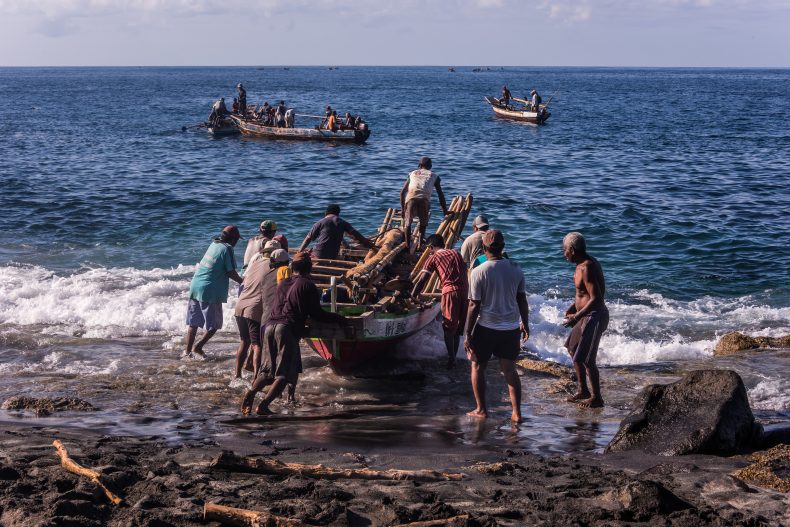
Once a whale is spotted, there is a mad sprint to the beach where the traditional Paledang boats will be immediately taken to the sea. Photo by Claudio Sieber.
On the Whale Hunt
On a sunlit Friday afternoon, I reach the small bay of Lamalera, just when the fishermen are about to land their freshly speared sea harvest. Everyone congregates to help push the Johnsons back into the shelters, even the youngest children and a one-armed elder. It seems they have been quite successful today; roughly a dozen manta rays, a marlin, a dolphin, a black giant tortoise, and a shark are pulled ashore to be chopped up shortly after. If there is some spare time, the boys will merrily paddle around on their Styrofoam blocks, go surfing on their wooden boards, or practice throwing a bamboo stick in imitation of the honorable Lamafa – the chief harpooners – they aim to become one day.
It’s one of the last days before the Leva Season is officially to be announced. Once a whale is spotted, there is a mad sprint to the beach, where the traditional Paledang boats will be immediately taken to the sea once the clans reached shore. By lucky chance, I’m able to follow the crew of Petrus Glau Blikolulong or “Papa Petro” — a highly respected Lamafa for 21 years. Experienced Lamafa like Papa Petro enjoy tremendous appreciation from the whole village, as they shoulder a weighty responsibility for the community. The Lamafa tradition is handed over within the 10 clans, though within the main family if possible. Traditionally a young fisherman will work his way up to that very position after being water bailer or spotter. If he’s able to prove his courage to the crew, he might be elected to take the place of one of the 20 aging Lamafa in Lamalera.
Our Paledang glides to sea. We’re the very last crew to go on this thrilling voyage. I situate myself between ropes and blood-encrusted planks. “If you don’t behave we’ll use you as shark bait,” jokes old Papa Lausan, flashing a smile with his two leftover teeth. In front of me sits the “Breung Alep,” the assistant of Lamafa Petrus. He is almost equally important because of his responsibility to manage the “Leo,” the sacred rope which is attached to the hook. In the back sits another VIP, the “Tuan Perahu” — the boat boss, who governs control of the Paledang. Some more sailors act as whale spotters monitoring all directions, or pour out the water in our boat. While we’re being dragged from the Johnson, Papa Petro persistently sharpens the hook until he proclaims it to be spiky enough and stuffs it onto the 4 meter long bamboo cane.
And there he is! The sperm whale of Moby Dick fame. The narrow boat deck is overtaken by a bloodthirsty mood driven by decades of experience in collective baiting. We let go the rope that connects us to the engine-powered boat and approach the giant by rowing so as to remain in long-established boundaries. Harpoon at the ready, Petrus awaits the right moment, and finally leaps off, using the force of his own body weight and the iron tip of the bamboo harpoon to pierce the thick skin of the sperm whale. If the Lamafa is successful, the boat will be connected to the whale by a Leo at the end of the harpoon. The whale may try to dive deep, aiming to escape, putting the boat and the crew at risk. Whales can take hours to tire, even after being speared by multiple harpoons. So you might be dragged along at full speed for several hours — a situation that old Western whalers knew as the “Nantucket sleigh ride.” In our case, Petrus pierced the whale’s flesh, but its tail somehow shook off the harpoon – thus the wounded whale contrived to escape and is now on the loose.
The Johnson crew hurries back and we start chasing the whale once again. The ghastly reality is that a great deal of hunting a whale consists of being exposed to a merciless sun for hours while scouting desperately for a surfacing whale tail. Manuel Toba Bataona (Papa Manuel) explains a harrowing experience his boat had in 1994:
I and my crew got dragged from a whale as far as Timor, which is roughly 100 kilometers away from Lamalera. The crew was stranded for five days in the Savu Sea without any food or water. We had been so hungry so that we ate our shirts to feel full. We were surely aware that God might call us to heaven, and we had been ready to accept our destiny. By otherworldly luck, a passenger boat sighted us after five days and brought us to the city of Kupang. Nevertheless, the following day we went out hunting again!
On board our boat, no one dares to say a word. It’s so silent, that even the rustle of a shipmate’s self-rolled cigarette made of tobacco and dried palm leaves can be heard. Meantime, I am struck with the singular posture Petrus maintains. Our Lamafa stands erect and motionless, looking straight out beyond the ship’s ever-pitching prow. We’re about 10 kilometers away from Lamalera, and after some hours of spotting around the decision is made to venture back empty-handed.
It frequently happens that when several Paledang are cruising in company, a whale might be struck by the harpoon of one Lamafa, then escape, and be finally killed and captured by another one. A week later, the body of the whale speared by Lamafa Petrus was found dead, floating at sea. The whale was eventually retaken by the crew of Lamafa Goris. It requires over a dozen men to tie up this weighty gift, which was then tugged alongside the boat to shore.
While the clan is waiting for low tide to bring the whale ashore, they will ostentatiously sharpen their knives. The butchery of a 15-meter long sperm whale is quite a hideous scene as one may imagine. I’m told that for bigger whales, they’d use chainsaws. But for this rather small fellow, knives should get the job down. Participating crew members will be rewarded with a share based on their role; the decision of which party will get what whale part comes from the boat maker of the traditional Paledang – the “Ata Molan.”
The whalers with their entire families in tow carve away blocks of blubber and strip the whale to the last piece. Not too long ago, even the blood was used for cooking a hearty soup. All parts have their own benefit and purpose. Whereas some exotic parts like a whale penis can only be used for Chinese medicine (think traditional viagra), the blubber and innards are of greater use. The most famously useful part of the whale is its highly flammable oil, which serves as fire kickstarter and old-fashioned lamp oil, sometimes as cooking oil, and even as nutrition for children (a rich source of omega-3 fatty acids). Some of these whales will yield upwards of 30 gallons of oil.
But for the Lamalera, the most essential part of a whale is obviously its meat, which in sundried slices will help many families to survive the upcoming days.
“This is about survival,” says Yosef Bataona. “[…]Lately, we have been getting lots of pressure from the media world etc. but no one seems to really understand the deeper sense of our situation. Our people here struggle for one spoon of rice or a piece of corn. There is no fertile soil and the entire topography is stony which makes growing crops impossible, so we have no choice but to take full advantage of what the sea offers us.”
Claudio Sieber is an emerging photojournalist from Switzerland currently based in Southeast Asia. His work has been featured in over 30 publications, including Asian Geographic, Hakai, Terra Mater, GEO, the New York Post, and the Guardian. He specializes in recording the traditions and lifestyles of various Asian cultures.













